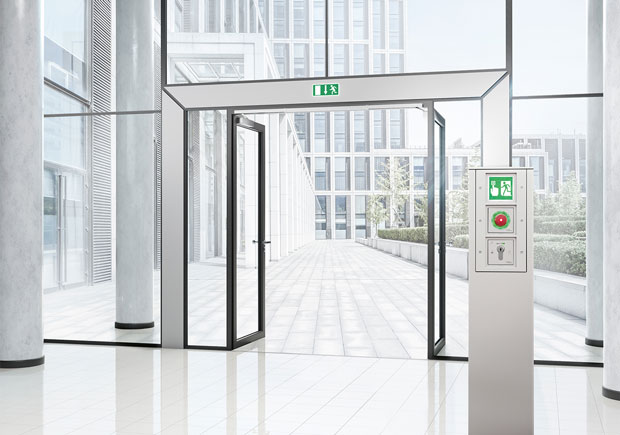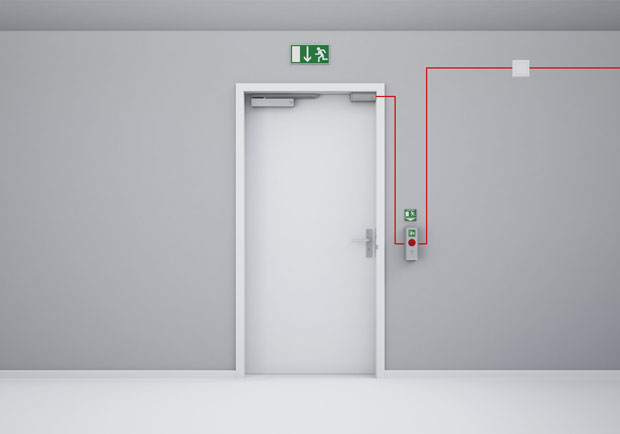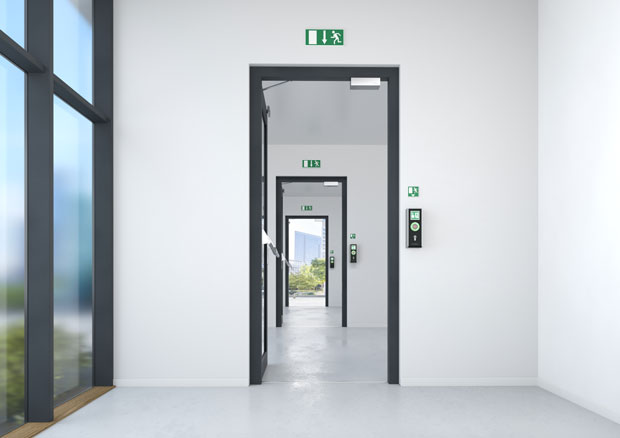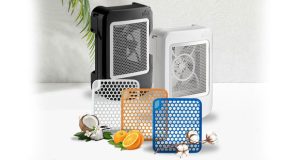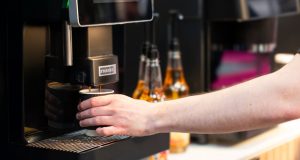When it comes to door hardware, balancing safety and security can be a challenge. Compliant with BS EN 13637, dormakaba’s SafeRoute emergency exit and escape route system has been developed to provide enhanced security for buildings while still ensuring safe and efficient evacuation in an emergency.
Ensuring safe and efficient evacuation of building occupants in an emergency is of course essential. There is also a need to keep the building secure and prevent unauthorised access during normal use and building and facilities managers will no doubt recognise that as a consequence, emergency exits can represent a weak-point.
The typical solution to meeting both requirements is to use emergency escape locks with automatic self-locking mechanisms. This allows the door to be opened easily from the inside during an emergency situation, but it locks again as soon as the door closes, preventing unauthorised access from outside. However, this approach does not prevent misuse of the emergency exit.
For example, in office buildings, it may be that employees misuse the emergency exit doors as an alternative exit from the building in a non-emergency situation. In shopping centres and retail environments, the emergency exit could be used as a getaway route out of the building for thieves. In care homes, hospitals and educational and child-care settings the emergency exit is a potential way for vulnerable people to leave without supervision.
dormakaba’s SafeRoute escape route security system can intelligently combine diverse, often contradictory door requirements to overcome such challenges. It monitors and controls the locking devices of doors in escape routes in accordance with EN 13637 (the standard for electrically controlled exit systems used on escape routes) and is also compliant with fire door standards so it can be used on all doors on the escape route, including certified fire doors. During day-to-day operation, the door remains locked to prevent misuse or unauthorised access. The solution and can be applied to single doors, groups of up to four doors connected to a single control unit, or as a network solution for larger buildings.
One of the notable features of SafeRoute is its delayed egress function which allows a time delay (and an alert) between someone pressing the emergency exit button and the release of the door – without violating any building rules in the process. This delay is particularly beneficial for building owners looking to prevent theft, by allowing security personnel to reach the perpetrator before they can get away. It is also ideal in settings where there are vulnerable occupants who would be at risk if they should find a way out of the building unsupervised. Here, SafeRoute’s time delay provides sufficient reaction time for the supervisory staff and carers to prevent an unauthorised exit.
In addition, the SafeRoute system can help prevent non-emergency use of the door. Through a central management control (CMC), SafeRoute provides real time alerts when an emergency exit is activated to provide a warning of unauthorised use. The CMC also allows building operators to view the status of each door connected to the system and to lock or unlock individual or groups of doors remotely.
SafeRoute provides additional functionality for specific types of building. For secured areas, such as staff areas of airports, an escape route may include a series of access controlled doors that must be released in an emergency. Standalone door releases can prove impractical and can slow the evacuation. SafeRoute enables a predetermined series of doors to be released in an emergency to allow swifter evacuation but with the final external door or exit into the public area still secured, which can be released as needed.
In addition, for areas where clinical hygiene must be maintained, such as for operating theatre entrances and clean rooms, SafeRoute can be used to create an airlock system on an escape route. In normal use, one door can only be opened if the other is closed and locked.
For large buildings used by the public, such as music, sports and entertainment venues, people will likely be unfamiliar with the layout and escape routes, making safe and swift evacuation a challenge. SafeRoute enables the emergency exit doors to all be released using the CMC, or automatically when a fire is detected. SafeRoute also integrates with other parts of the building’s security and access system, such as turnstiles and speed gates. This allows these to be released in an emergency to streamline evacuation further. In addition, with motorised door operators fitted to internal escape route doors, SafeRoute allows these to be opened automatically for barrier free evacuation.
SafeRoute has been designed to enable easy and straightforward installation and the system’s preconfigured parameters are suitable for many applications to make commissioning simple. Where the standard parameters are not fully suitable, further customisation is possible with the TMS Soft® door management software. The system’s flexible subscription-free licencing model ensures SafeRoute is cost effective for buildings of all sizes, where the functionality of the system is easily determined by a licence card. Facilities managers can simply purchase the options that best meet their needs. If necessary, the system can be upgraded or be adapted to the building’s needs at any time through licence expansion and simply by swapping the cards, with no need for hardware changes.
With a flexible and modular design, SafeRoute offers a comprehensive solution for securing emergency exit doors. The system ensures safe and efficient evacuation in an emergency while delivering enhanced security during day-to-day use that complies with the regulations. To find out more about SafeRoute visit www.dormakaba.com/gb-en/saferoute-escape-route.

